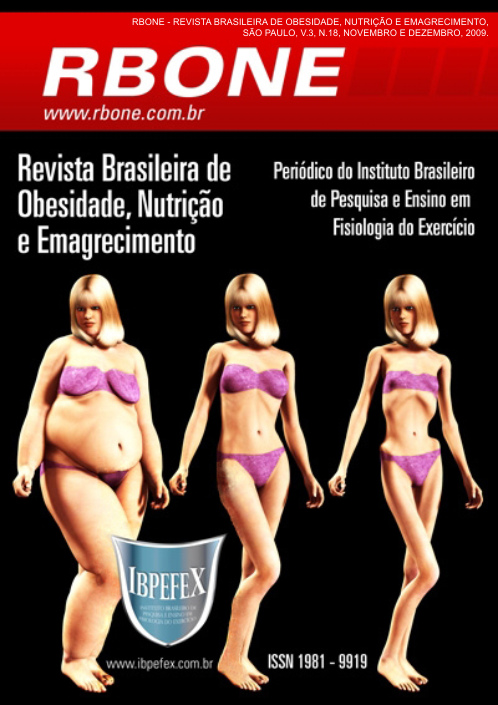Evaluation of the coronary risk in women through indicating parameters anthropometrics of obesities
Abstract
Objective: To characterize coronary risk in women attending two projects Extension School of Biomedical Sciences Cacoal. Materials and Methods: The sample consisted of 193 women divided into five age groups, respectively: 15 to 29 years, 30 to 39 years, 40 to 49 years, 50 to 59 years and above 60 years, which included measurements of circumference waist and hip as a predictor of waist-to-hip ratio (WHR), weight and height for predicting body mass index (BMI). Results: The distribution of the sample in the ratings percentage of age group, it appears that the first age group (15 to 29 years) accounted for 57.0% of the sample, the second (30 to 39 years) to 16.6% the third (40 to 49 years) to 13.5%, the fourth (50 to 59 years) to 9.3% and the last (60 over) to 3.6% and the mean and standard deviation of age is generally presented at 30.7 ± 14.3 years. The mean and standard deviation of BMIchecked by age group was the following: (15 to 29 years) 21.50 ± 3.66; (30 to 39 years) 25.73 ± 5.38; (40 to 49 years) 25, 63 ± 4.16; (50 to 59 years) 26.41 ± 5.2 and (60 above) 28.54 ± 1.6. The mean and standard deviation of the ratio of WHR verified by age group was the following: (15 to 29 years) 0.7289 ± 0.06, (30 to 39 years) 0.7942 ± 0.06, (40 to 49 years) 0.7878 ± 0.08 (50 to 59 years) and 0.8270 ± 0.09 (60 above) 0.8944 ± 0.03. Conclusion: There is a correlation between the variables BMI and WHR ingeneral it takes to understand that the body fat of the sample is well distributed which may explain the reduced coronary risk by treating the sample as a whole.
References
-Farmer, J.; Gotto, A. Dyslipidemia and other risk factors for coronary artery disease. In. Braunwald E. (Ed.). Heart disease: a text book of cardiovascular medicine. Philadelphia: Saunders Company, 1997.
-Guedes, D.P.; Guedes, J.E.R.P. Controle do peso corporal. Londrina: Midiograf, 1998.
-Guimarães, F.J.S.P.; Pires Neto, C.S. Características antropométricas e da composição corporal esuas relações com doenças degenerativas (1998) Disponivel em: <http://www.upe.br/corporis2/artigo3html>. Acesso em: 30 jun. 1998.
-Hubert, H.B.; Feinleib, M.; McNamara, P.T.; Castell, W.P. Obesity as an independent risk factor for cardiovascular disease: a 26-years follow-up of participants in the Framingham Heart Study. Circulation.1983; Vol. 67. Num. 5. 1983. p. 968-977.
-Ito, H.; Nakasuga, K.; Ohshima, A.; e colaboradores. Detection of cardiovascular risk factors by indices of obesity obtained from anthropometry and dual-energy x-ray absorptiometry in Japanese individuals. Int J Obes Relat Metab Disord. Num. 27. 2003. p. 232-237.
-Lessa,I. O Adulto brasileiro e as doenças da modernidade: epidemiologia das doenças crônicas não-transmissíveis. São Paulo: Editora Hucitec-Abrasco; 1998.
-Monteiro, J. Obesidade: diagnóstico, métodos e fundamentos. In: HALPERN, Alfredo. Obesidade, São Paulo: Ed. Lemos, p. 31-53, 1998.
-OMS (Organización Mundial de la Salud). La Salud de los Jóvenes: Un Reto y una Esperanza. Geneva: 1995.
-Pitanga, F.J.G. Testes, medidas e avaliações em educação física e esportes. São Paulo: Phorte, 2008.
-Pitanga, F.J.G.; Lessa, I. Prevalência e fatores associados ao sedentarismo no lazer em adultos. Cadernos de Saúde Pública. Vol. 21. Num. 3. 2005. p. 870-877.
-Sharkey, B.J. Condicionamento físico e saúde. Porto Alegre: Artmed, 1997.
-Vague, J. The degree of masculine differentiation of obesities: A factor determining predisposition to diabetes, atherosclerosis, gout, and uric calculous disease. Am J Clin Nutr. Num. 4. 1956. p. 20-34.
-Word Health Organization. Obesity: preventing and managing the global epidemic. Report of a WHO consultation on obesity. Geneva, June 3-5, 1997. Geneva: WHO; 1998.
-Zanella, M.T. Obesidade. In: Mion D-Junior, Nobre F. Risco Cardiovascular Global. São Paulo (SP): Lemos Editorial; 1999. p. 103-14.
Authors who publish in this journal agree to the following terms:
- Authors retain the copyright and grant the journal the right of first publication, with work simultaneously licensed under the Creative Commons Attribution License BY-NC which allows the sharing of the work with acknowledgment of the authorship of the work and initial publication in this journal.
- Authors are authorized to enter into additional contracts separately for non-exclusive distribution of the version of the work published in this journal (eg, publishing in institutional repository or book chapter), with acknowledgment of authorship and initial publication in this journal.
- Authors are allowed and encouraged to post and distribute their work online (eg, in institutional repositories or on their personal page) at any point before or during the editorial process, as this can bring about productive change as well as increase impact and impact. citation of published work (See The Effect of Free Access).






